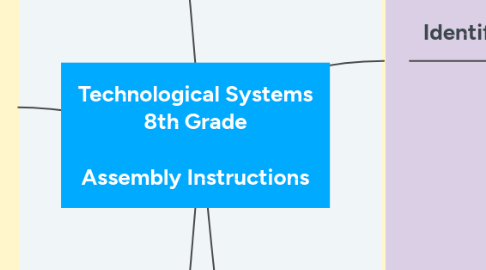
1. Identify & Plan
1.1. Measurable Goals & Outcomes
1.1.1. Outcome 1 - After completion of this module, students will gain knowledge of technical information and concepts used in creating technical assembly instructions to understand how technological systems work.
1.1.1.1. Objective 1.1 - By the end of lesson 1, the student will define basic terminology used in technical instructions.
1.1.1.2. Objective 1.2 - By the end of lesson 2, the students will analyze a set of technical instructions provided by the instructor by answering a set of questions.
1.1.1.3. Objective 1.3 - By the end of lesson 3, the students will identify basic concepts in creating technical assembly instructions by...
1.1.2. Outcome 2 - After completion of this module, students will demonstrate mastery of technical instructions by creating a set of assembly instructions.
1.1.2.1. Objective 2.1- By the end of lesson 1, the student will produce a outline or storyboard of their assembly instructions.
1.1.2.2. Objective 2.2 - By the end of lesson 2, the student will produce a set of assembly instructions.
1.1.2.3. Objective 2.3 - By the end of lesson 3, the student will evaluate other students assembly instructions to provide constructive feedback to their peers.
1.2. Duration of Course
1.2.1. Outcome 1: 2 days
1.2.2. Outcome 2: 5 days
1.3. Target Audience
1.3.1. Students enrolled in 8th grade Technology Education at Oklahoma Road Middle School, MD
1.3.1.1. Approximately 120 students
1.3.1.2. predominately conservative suburban area
1.3.1.3. predominately middle-class
1.3.1.4. familiar with EDP and Google Classroom
1.3.1.5. range of disabilities (emotional and physical)
1.3.1.6. able to connect from mobile device at home
1.3.1.7. All students have access to mobile device at home or at school.
1.4. Type of Course
1.4.1. Hybrid
1.4.1.1. Using either a personal mobile device or notebook to plan
1.4.1.2. assembly object is provided in class
1.4.2. All Virtual
1.4.2.1. All work is submitted through Google Classroom
1.4.2.2. assembly object is not provided (can be flashlight, pen, etc...)
2. Learning Theories
2.1. Active Learning Theory
2.1.1. "Learning by doing"
2.2. Objectivism
2.2.1. "retrieve, process, new information, store"
3. Methodology
3.1. SAM
3.1.1. Non-linear, flexible, evaluative, quick
4. Describe
4.1. Activities
4.1.1. Matching, Drag and Drop,interactive
4.1.2. Games (Assemble something with the student's instructing the teacher.)
4.2. Assessments
4.2.1. Defintions
4.2.2. Identify key concepts of assembly instructions
4.2.3. Formative: Constructive feedback of peer work
4.2.4. Summative: Assembly Instructions
4.3. Collaboration
4.3.1. Discussion - Synchronous on origami warmup
4.3.2. Work in teams to create and evaluate assembly instructions.
4.3.3. Work in teams to evaluate assembly instructions.
4.3.4. Possibly use FlipGrid
4.4. Learning Material
4.4.1. Terms
4.4.2. Examples of past projects
4.4.3. Scencarios?
5. Evaluation
5.1. Evaluative Research Plan
5.1.1. To be continued modules 2-5
